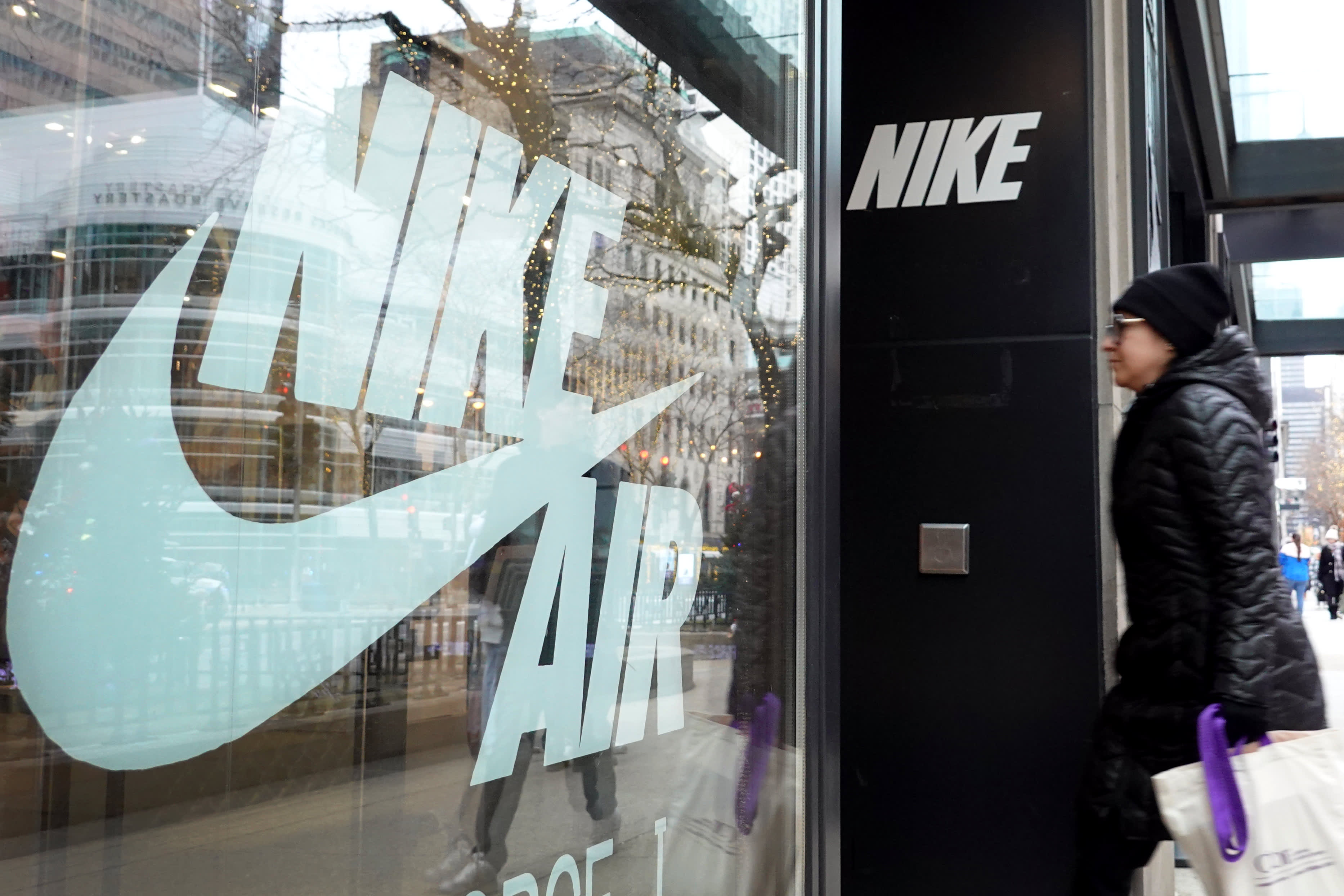
A customer enters a Nike store along the Magnificent Mile shopping district on December 21, 2022 in Chicago, Illinois.
Scott Olson | Getty Images
Nike missed on earnings Thursday for the first time in three years, as the retailer reported lower margins that weighed on profits during its fiscal fourth quarter.
Shares dropped more than 4% in extended trading. The stock has fallen about 3% this year.
Here’s how the sneaker giant performed during the quarter compared with what Wall Street was anticipating, based on a survey of analysts by Refinitiv:
- Earnings per share: 66 cents vs. 67 cents expected
- Revenue: $12.83 billion vs. $12.59 billion expected
The company’s reported net income for the three-month period that ended May 31 was $1.03 billion, or 66 cents per share, compared with $1.44 billion, or 90 cents a share, a year earlier. Earnings came in below Wall Street’s expectations, in a rare miss for the retailer.
Sales rose to $12.83 billion, up about 5% from $12.23 billion a year earlier and ahead of Wall Street’s estimates. The company beat revenue estimates for the seventh straight quarter, as sales surged in China after the country rolled back pandemic restrictions.
For its full fiscal year, Nike’s revenue was $51.2 billion, up 10% compared to the prior year. It beat analysts’ expectations of $50.99 billion, according to Refinitiv.
However, profits for the full year also came in below expectations. The athletic apparel retailer reported earnings per share of $3.23, just short of the $3.24 Wall Street had expected, according to Refinitiv. Nike’s net income for the year was $5.1 billion, down 16% compared to the prior year.
The company offered muted guidance for the year and quarter ahead as it watches the broader economy, consumer behavior and retail trends.
For fiscal 2024, the retailer expects revenue to grow mid-single digits. Analysts had expected year over year growth of 6.3%, according to Refinitiv. Given the current macro environment, Nike feels like its forecast is a “great number,” Friend said.
The company expects gross margins to improve between 1.4 and 1.6 percentage points for the year.
In the quarter ahead, it forecast revenue to be flat to up low single digits. Analysts had expected sales growth of 5.8%, according to Refinitiv. It also anticipates gross margins in the quarter will be down 0.5 to 0.75 percentage points.
Margin pressure hits Nike
While Nike is among the top athletic apparel retailers, it’s not immune to overall softness in the footwear and apparel categories that has plagued its competitors.
The industries have been hit particularly hard as consumers pull back on spending and get more selective about where they spend their discretionary dollars. That in turn has forced Nike and other retailers to spend more on marketing and promotions to drive volume, which has pressured margins.
Nike’s gross margins fell 1.4 percentage points during the fourth quarter to 43.6%, contributing to the earnings miss. Margins narrowly beat analysts’ expectations of 43.5%, according to StreetAccount. The company attributed the drop to higher product input costs, elevated freight and logistics expenses, higher promotions used to clear excess inventory and unfavorable currency exchange rates.
Other retailers that reported earnings recently noted freight and logistics costs had gone done for them, providing a boon for their margins after supply chain headaches subsided.
Nike said it expects the pressure to lift. The company anticipates “above average margin improvement” in fiscal 2024, Chief Financial Officer Matthew Friend said during a call with investors.
For the last several quarters, Nike has grappled with bloated inventory levels, which have also weighed on its margins. Inventory value came in at $8.5 billion at the end of the fourth quarter, which is flat compared with the prior-year period. But quarter over quarter, Nike offloaded about $400 million in inventories.
Units decreased double digits across footwear and apparel compared to the previous year, Nike said.
Still, inventories are running around 23% above levels seen in 2021, prior to the supply chain constraints that caused inventory woes across the industry, according to retail analyst Neil Saunders, the managing director of GlobalData.
“In our view, Nike has been caught on the hop in term of the levels of stock it ordered; and it was too slow to react to the more sluggish levels of growth that have come with a challenging consumer economy,” said Saunders.
While inventories are also still higher than pre-pandemic levels, the company said it’s in a “healthy” position.
“When we step back and look at the actions that we took last year, we’re very happy with where we finished the year and in fact our inventory levels are ahead of our plan and ahead of the competition,” Friend said during the investor call.
Nike has been relying on its wholesale partners to reduce inventory levels. The push boosted its wholesale revenue over the past few quarters, which also cut into its margins.
Revenue from that segment started to moderate in the company’s fourth quarter. Sales from Nike’s wholesale segment came in at $6.7 billion for the quarter, down 2% from the year-ago period.
Still, Nike recently restored some of the wholesale relationships that it cut when it first began focusing on its direct-to-consumer strategy in 2020.
Both DSW and Macy’s will start selling a range of Nike merchandise again in October, the retailers both announced in June.
Macy’s hasn’t received a shipment from Nike since December 2021, but will now resume selling its apparel, including plus size women’s, big and tall men’s, kid’s, bags and other gear, the department store told analysts during an earnings call. Nike’s more premium offerings appear to be off the table for sale at Macy’s.
The decision to bring Macy’s and DSW back under the Nike fold has left some investors wondering if the company is moving away from its direct-to-consumer strategy, which is still bringing in high sales even though it comes at a cost.
As the company carries out the shifts, Nike CEO John Donahoe pushed back on claims that its strategy is changing. He said its primary focus is on where consumers want to shop.
“Consumers want digital and physical access, they shop across both channels, they want mono-brand and multi-brand. They use different shopping occasions to use different channels,” said Donahoe.
He acknowledged “multi-brand wholesale partners play a really important role.” Donahoe said Nike has a variety of clients that help it reach “distinct segments of consumers or price points.”
“So what we’ve done over the past quarter is simply an extension of that. Our direct business will continue to grow the fastest but we’ll continue to expand our marketplace strategy to enable access to as many consumers as possible and drive growth,” he said.
Sales from Nike’s Direct channel rose 15% year-over-year to $5.5 billion. Sales at Nike-owned stores and its online channels led the growth. At stores, sales jumped 24% and online, revenue climbed 14%.
Member engagement grew on all of Nike’s digital platforms and buying frequency hit an all-time high during the quarter, executives said.
Nike’s selling and administrative expenses jumped 8% in the quarter to $4.4 billion and have been steadily climbing. Operating overhead expenses increased 10% to $3.3 billion, which the company attributed to wage-related expenses and variable costs associated with its direct to consumer channel.
China sales give a boost
Since the Covid pandemic began, investors have been watching to see how sales have rebounded in China following sweeping lockdowns. Some signs of recovery are starting to show.
During Nike’s fourth quarter, sales in China rose 16% year-over-year to $1.81 billion, ahead of Wall Street’s estimates of $1.68 billion, according to StreetAccount.
Donahoe said it’s “clear” that consumers are back in China and that the Nike and Jordan brands are strong in the region.
While sales jumped significantly, Nike is up against easy comparisons in the region. During Nike’s fiscal fourth quarter in 2022, China was still grappling with lockdowns.
Sales rose across all of Nike’s other markets. In North America, sales climbed 5% to $5.36 billion, compared with estimates of $5.29 billion, according to StreetAccount. In Europe, the Middle East and Africa, sales rose to $3.35 billion, compared to estimates of $3.04 billion. In the Asia Pacific and Latin America regions, sales came in at $1.7 billion, a slight miss from analysts’ expectations of $1.72 billion.
Revenue for Converse, on the other hand, came in far below estimates. Sales for the brand slid 1% during the quarter to $586 million, below the $615.7 million analysts had been anticipating, according to StreetAccount.
Read the full earnings release here.








